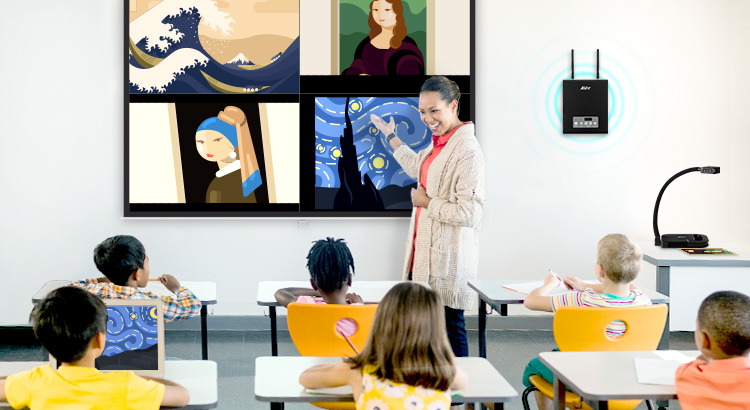The sight of stained tubes of oil paint scattered around, the sounds of pages flipping on giant sketch pads and hurried scratches of charcoal, and the smell of brushes soaking in turpentine—these are a few of the sensory perceptions that likely come to mind when you think of fine art class. Notice that there are no tablets, PCs, or smartphones in that mental conjuring. Maybe a camera will sneak its way in for photography class, but that’s about it.
Now, obviously, modern artists lean heavily on software and various smart devices for graphic design, animation, and more. However, technology can also play a role in a traditional fine arts class that focuses on foundational mediums like pencil drawing and watercolor painting. As an article by Acer for Education puts it, “the separation between technology and the arts is a false dichotomy and the two can be gainfully used together.”
Any device you use in your other classes has a place in your art class, too. Visualizers (document cameras) and interactive control boxes that connect student and teacher devices for content sharing are especially useful.
Visualizers

How they work: Visualizers provide a camera on a movable arm that allows you to project images of documents, models, and even self-view to a monitor or student devices (via software). They can also capture images and videos.
Some ideas for using them in fine art class
- Place a wooden art mannequin under a visualizer to model for your students. You can easily capture it from any angle with the visualizer’s adjustable arm, magnifying it to lifelike size via your class display. This saves space and money, as you don’t need to purchase and store mannequins in bulk.
- With a visualizer you can easily show details from pictures in art books. That means you don't need to require students to all purchase the same book or pass one copy around. High-powered zooms take you and your students closer than any museum would ever allow to the brush strokes in Da Vinci’s "Mona Lisa" or Dali’s surrealist masterpieces.
- Demonstrate pencil-drawing shading techniques under a visualizer positioned as an overhead camera, and then adjust to self-view to model pointillism on a canvas at a standing easel. Even back-row students can easily see without having to leave their desks to get a closer look.
- Let students use a visualizer in self-view to make time-lapse videos of their creations coming to life. Top-quality visualizers also feature image capturing capability and work with compatible software that lets students grab images of in-progress oil paintings and upload them to the cloud for reference at home, since they have to leave their artwork at school to dry.
Additionally, if you have a USB visualizer, you can use it as a third-party camera to implement most of the above ideas in classes livestreamed on Facebook, YouTube, or wherever you like to stream.
Control Boxes

How they work: Control boxes magically transform traditional classroom equipment into state-of-the-art (or state-of-the-fine-art) EduTech by easily connecting to any display or projector and enabling screen sharing, annotation, and split-screen comparisons.
Some ideas for using them in fine art class
- Ask students to choose a renowned piece of art to reproduce. Then, use a control box to compare student versions of the famous works of art side-by-side on the classroom display. If you have a high-quality control box, you’ll be able to split your screen up to four ways for comparing multiple student copies of the same piece.
- Download your favorite art apps to the control box so that you can share them with the entire class. For example, if you don’t have a visualizer to pair with the control box, you could download an art mannequin app, like Manikin, which enables you to set the lighting, include various objects, and create scenes with multiple models in addition to basic posing with a digital mannequin. You could also have students create scenes on their tablets and share them to the class display to see who can come up with the most challenging one.
- When you’re mixing a little art history into your class, you can use the split screen feature to display four close-up shots of various works. Have students guess the artist based on the style or color palate for fun or for a pop quiz.
The "Starry Night Sky" is the limit when it comes to integrating a visualizer or a control box into your fine art curriculum. So, what are you waiting for? Inject some tech into your class today!